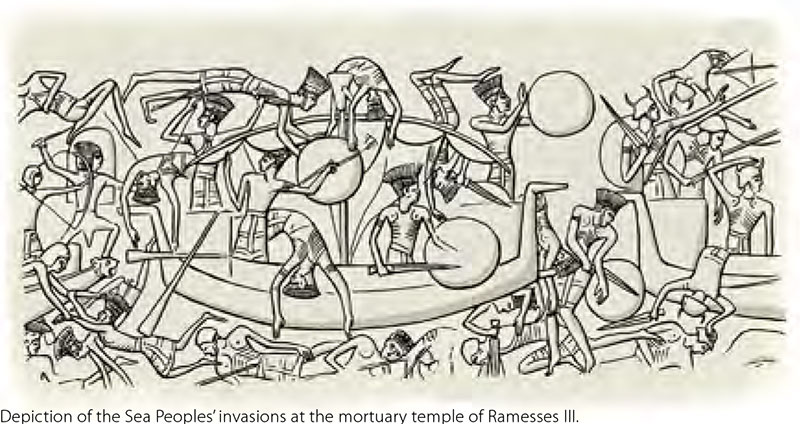New paper (behind paywall) Ancient Rome: A genetic crossroads of Europe and the Mediterranean, by Antonio et al. Science (2019).
The paper offers a lot of interesting data concerning the Roman Empire and more recent periods, but I will focus on Italic and Etruscan origins.
NOTE. I have updated prehistoric maps with Y-DNA and mtDNA data, and also the PCA of ancient Eurasian samples by period including the recently published samples, now with added sample names to find them easily by searching the PDFs.
Apennine homeland problem
The traditional question of Italic vs. Etruscan origins from a cultural-historical view* lies in the opposition of the traditional way of life during the Bronze Age as opposed to increasingly foreign influences in the Final Bronze Age, which eventually brought about a proto-urban period in the Apennine Peninsula.
* From a modern archaeological perspective, as well as from the (unrelated) nativist view, “continuity” of ancient cultures, languages, and peoples is generally assumed, so this question is a no-brainer. Seeing how population genomics has essentially supported the cultural-historical view, dismissing the concepts of unscathed genomic or linguistic continuity, we have to assume that different cultures potentially represent different languages, and that genetic shift coupled with radical cultural changes show a strong support for linguistic change, although the later Imperial Roman period is an example of how this is not necessarily the case.

A little background to the Italic vs. Etruscan homeland problem, from Forsythe (2006) (emphasis mine):
While the material culture of the Po Valley developed in response to influences from central Europe and the Aegean, peninsular Italy during the late Bronze Age lagged somewhat behind for the most part. Inhumation continued to be the funerary practice of this region. Although agriculture doubtless remained the mainstay of human subsistence, other evidence (the occupation of mountainous sites not conducive to farming, the remains of cattle, sheep, pigs, and goats, and ceramic vessels used for boiling milk and making cheese) indicates that pastoralism was also very widespread. This suggests that transhumance was already a well-established pattern of human existence. In fact, since the material culture of central and southern Italy was relatively uniform at this time, it has been conjectured that this so-called Apennine Culture of c. 1600–1100 B.C. owed its uniformity in part to the migratory pattern characteristic of ancient Italian stockbreeding.
During the first quarter of the twelfth century B.C. the Bronze-Age civilizations of the eastern Mediterranean came to an abrupt end. The royal palaces of Pylos, Tiryns, and Mycenae in mainland Greece were destroyed by violence, and the Hittite kingdom that had ruled over Asia Minor was likewise swept away. The causes and reasons for this major catastrophe have long been debated without much scholarly consensus (see Drews 1993, 33–96). Apart from the archaeological evidence indicating the violent destruction of many sites, the only ancient accounts relating to this phenomenon come from Egypt. The most important one is a text inscribed on the temple of Medinet Habu at Thebes, which accompanies carved scenes portraying the pharaoh’s military victory over a coalition of peoples who had attempted to enter the Nile Delta by land and sea.
Iron metallurgy did not reach Italy until the ninth century B.C., and even then it was two or more centuries before iron displaced bronze as the most commonly used metal. Thus, archaeologists date the beginning of the Iron Age in Italy to c. 900 B.C.; and although the Italian Bronze Age is generally assigned to the period c. 1800–1100 B.C. and is subdivided into early, middle, and late phases, the 200-year interval between the late Bronze Age and early Iron Age has been labeled the Final Bronze Age.
During this period the practice of cremation spread south of the Po Valley and is attested at numerous sites throughout the peninsula. Since this cultural tradition developed into the Villanovan Culture which prevailed in Etruria and much of the Po Valley c. 900–700 B.C., modern archaeologists have devised the term “Proto-Villanovan” to describe the cremating cultures of the Italian Final Bronze Age.
The fact that some of the earliest urnfield sites of peninsular Italy are located on the coast (e.g. Pianello in Romagna and Timmari in Apulia) is interpreted by some archaeologists as an indication that cremating people had come into Italy by sea, and that their migration was part of the larger upheaval which affected the eastern Mediterranean at the end of the Bronze Age (so Hencken 1968, 78–90). On the other hand, the same data can be explained in terms of indigenous coastal settlements adopting new cultural traits as the result of commercial interaction with foreigners. In any case, by the end of the Final Bronze Age inhumation had reemerged as the dominant funerary custom of southern Italy, but cremation continued to be an integral aspect of the Villanovan Culture of northern and much of central Italy.

There is a myriad of linguistic reasons why eastern foreign influences can be attributed to Indo-European (mainly Anatolian, including a hypothetic influence on Latino-Faliscan) or Tyrsenian – as well as many other less credible models – and there is ground in archaeology to support any of the linguistic models proposed, given the long-lasting complex interactions of Italy with other Mediterranean cultures.
NOTE. The lack of theoretical schemes including integral archaeological-linguistic cultural-historical models due to the radical reaction against the excesses of the early 20th century have paradoxically allowed anyone (from archaeologists or linguists to laymen) to posit infinite population movements often based on the simplest similarities in vase decoration, burial practices, or shared vocabulary.
However, recent studies in population genomics have simplified the picture of Bronze Age population movements, identifying radical changes related to population replacements as opposed to more subtle admixture events. As of today, (France Bell Beaker-like) Urnfield stands as the most likely vector of Celtic languages; NW Iberian Bell Beakers as the vector of Galaico-Lusitanian; NW Mediterranean Beakers as the most likely ancestors of Elymian; the Danish Late Neolithic as representative of expanding Proto-Germanic; or Central-East Bell Beakers of Proto-Balto-Slavic.
With this in mind, the most logical conclusion is to assume that Alpine Bell Beakers (close to the sampled Italian Beakers from Parma or from southern Germany) spread Italo-Venetic languages, which is deemed to have split in the early to mid-2nd millennium BC, with dialects found widespread from the Alps to Sicily by the early 1st millennium BC.
Therefore, the two main remaining models of Italian linguistic prehistory – with the information that we already had – were as follows, concerning Tyrsenian (the ancestor of Etruscan and Rhaetian):
- It is a remnant language of the Italian (or surrounding) Chalcolithic, which survived in some pockets isolated from the Bell Beaker influence;
- It was a foreign language that arrived and expanded at the same time as the turmoil that saw the emergence of the Sea Peoples.
NOTE. Read more on Italo-Venetic evolution and on the likely distribution of Old European and Tyrsenian in the Bronze Age.
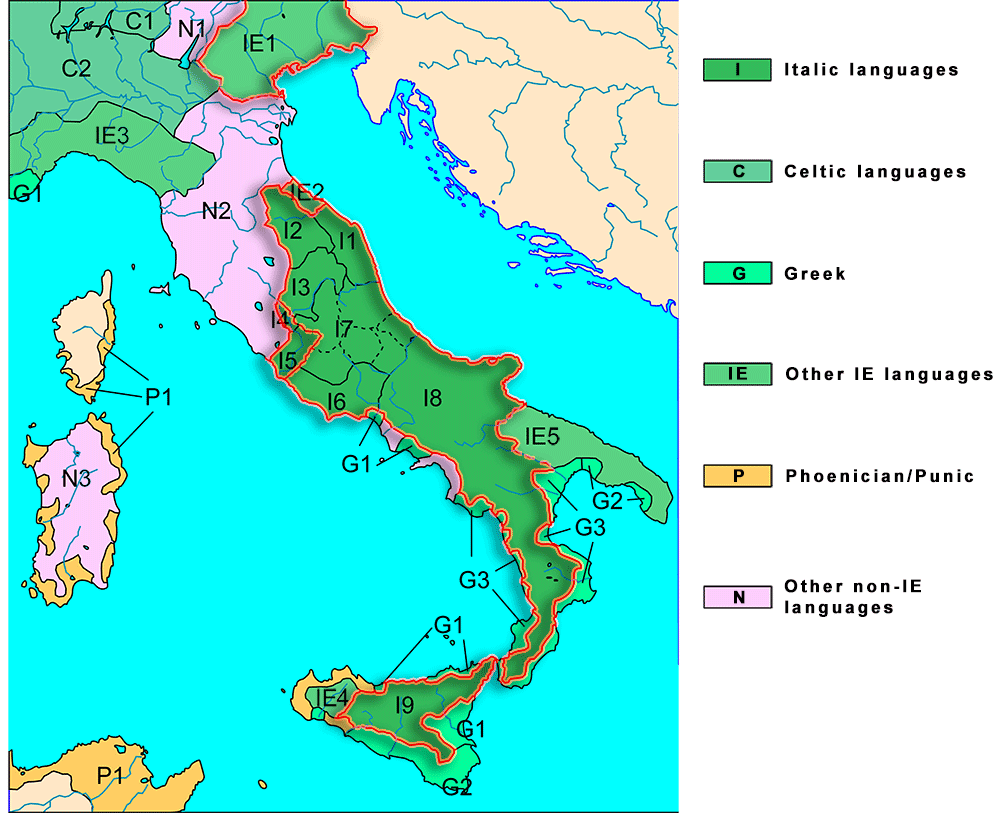
Proto-Villanovan
A Proto-Villanovan female from Martinsicuro in the Abruzzo coast (ca. 890 BC), of mtDNA hg. U5a2b, is the earliest mainland sample available showing foreign (i.e. not exclusively Anatolia_N ± WHG) ancestry:
Martinsicuro is a coastal site located on the border of Le Marche and Abruzzo on central Italy’s Adriatic coast. It is a proto-Villanovan village, situated on a hill above the Tronto river, dating to the late Bronze Age and Early Iron Age (…) finds from the site indicate an affinity with contemporaries in the Balkans, suggesting direct trade contacts and interaction across the Adriatic. In particular, the practice of decorating ceramics with bronze elements was shared between the Nin region in Croatia and Picene region of Italy, including Martinsicuro.
NOTE. These are just some of the models I have tried, most of them unsuccessfully. The standard errors that I get are too high, but I am not much interested in this sample that seems (based on its position in the PCA and the available qpAdm results) mostly unrelated to Italic and Etruscan ethnogenesis.
The sample clusters close to the Early Iron Age sample from Jazinka (ca. 780 BC), from the central Dalmatian onomastic region, on the east Adriatic coast opposite to Abruzzo, possibly related to the south-east Dalmatian (or Illyrian proper) onomastic region to the south. However, there is no clear boundary between hydrotoponymic regions for the Bronze Age, and it is quite close to the (possibly Venetic-related) Liburnian onomastic region to the north, so the accounts of Martinsicuro belonging to the Liburni in proto-historical times can probably be extrapolated to the Final Bronze Age.
NOTE. Based on feminine endings in -ona in the few available anthroponyms, Liburnian may have shared similarities with personal names of the Noricum province, which doesn’t seem to be related to the more recent (Celtic- or Germanic-related?) Noric language. On the other hand, anthroponyms are known to show the most recent hydrotoponymic layer of a region, so these personal names might be unrelated to the ancestral language behind place and river names.

Villanovan
A Villanovan sample from the powerful Etruscan city-state of Veio in the Tyrrhenian coast (ca. 850 BC), to the north of Rome, shows a cluster similar to later Etruscans and some Latins. Veio features prominently in the emergence of the Etruscan society. From The Etruscan World (2013) by Turfa:
In the final phase of the Bronze Age (mid-twelfth to tenth century bc) the disposition of settlements appears to be better distributed, although they are no longer connected to the paths of the tratturi (drove roads for transhumance of flocks and herds) as they had been during the Middle Bronze Age. As evidence of the intensive exploitation of land and continuous population growth there are now known in Etruria at least 70 confirmed settlements, and several more sites with indications of at least temporary occupation. The typical town of this chronological phase generally occupies high ground or a tufa plateau of more than five hectares, isolated at the confluence of two watercourses. These small plateaus, naturally or artificially protected, are not completely built up: non-residential areas within the defenses were probably intended as collecting points for livestock or zones reserved for cultivation, land used only by certain groups, or areas designated for shelter in case of enemy attack.
Taken together, the data seem to indicate the presence of individuals or families at the head of different groups. And in the final phase of the Bronze Age, there must have begun the process that generated (at least two centuries later) a tribal society based on families and the increasingly widespread ownership of land.
In the ninth century bc the territory is divided instead into rather large districts, each belonging to a large village, divided internally into widely spaced groups of huts, and into a small number of isolated villages located in strategic positions, for which we can assume some form of dependence upon the larger settlements.
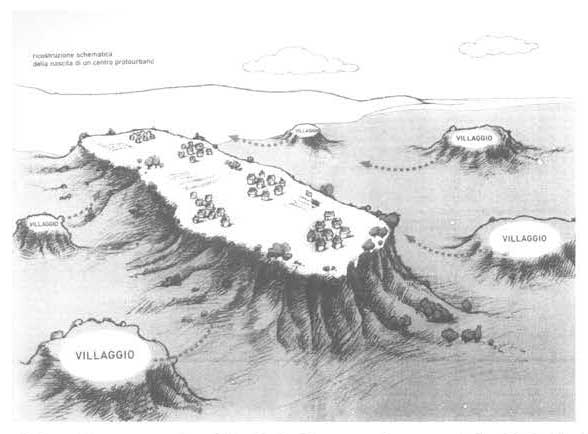
territoriale del Lago di Bolsena. Vol 1. Dalle origini alperiodo etrusco, Bolsena 2007). Modified from The Etruscan World (2013), by Turfa.
Compared to the preceding period, this type of aggregation is characterized by a higher concentration of the population. To the number of villages located mostly on inaccessible plateaus, with defensive priority assigned to the needs of agriculture, are added settlements over wide plains where the population was grouped into a single hilltop location. It is a sort of synoikistic process, so, for example, at Vulci people were gathered from the district of the Fiora and Albegna Rivers, while to Veii came the communities that inhabited the region from the Tiber River to Lake Bracciano, including the Faliscan and Capenate territories. The reference to Halesos, son of Saturn, the mythical founder of Falerii in the genealogy of Morrius the king of Veii (Servius, Commentary on Aeneid 8.285) may conceal this close relationship between Veii and the Ager Faliscus (the territory of the historical Faliscans).
The great movement of population that characterizes this period is unthinkable without political organizations that were able to impose their decisions on the individual village communities: the different groups, undoubtedly each consisting of nuclei linked by bonds of kinship, located within or outside the tufa plateaus that would be the future seats of the Etruscan city-states, have cultural links between them, also attested to by the analysis of craft production, such as to imply affiliation to the same political unit and enabling us to speak of such human concentrations as “proto-urban”.
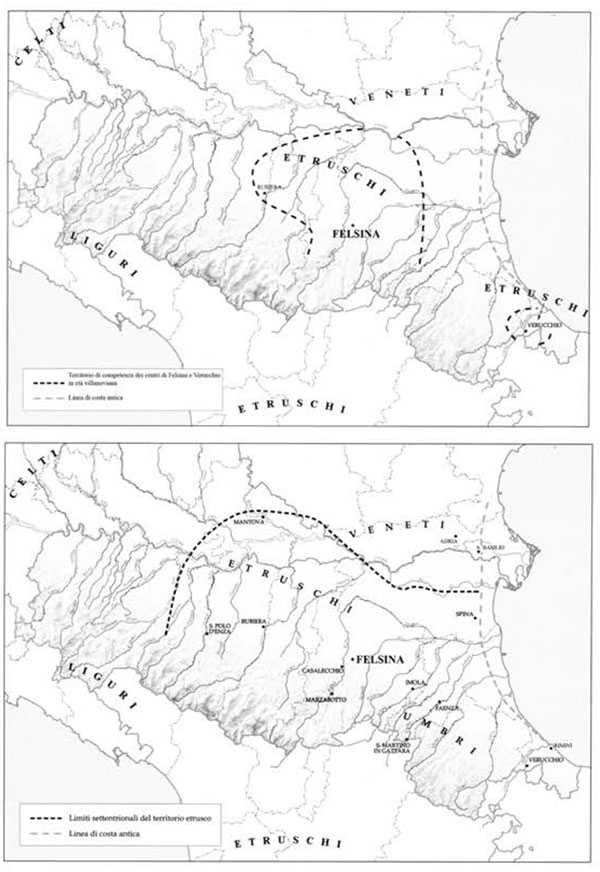
Italic vs. Etruscan origins
Four out of five sampled Latins show Yamnaya-derived R1b-L23 lineages, including three R1b-U152 subclades, and one hg. R1b-Z2103 (in line with the variability found among East Bell Beakers), while one from Ardea shows hg. T1a-L208. A likely Volscian (i.e. Osco-Umbrian-speaking) sample from Boville Ernica also shows hg. R1b-Z2118*, an ‘archaic’ (xL151) subclade within the L51 branch. These R1b-L23 subclades are also found later during the Imperial period, although in lesser proportion compared to East Mediterranean ones.
Among Etruscans, the only male sampled shows hg. J2b-CTS6190* (formed ca. 1800 BC, TMRCA ca. 1100 BC), sharing parent haplogroup J2b-Y15058 (formed ca. 2400 BC, TMRCA ca. 1900 BC) with a Croatian MBA sample from Veliki Vanik (ca. 1580 calBCE), who also clusters close to the IA sample from Jazinka.
Given the position of Latins and Etruscans in the PCA and the likely similar admixture, it is not striking that differences are subtle. From Antonio et al. (2019):
Interestingly, although Iron Age individuals were sampled from both Etruscan (n=3) and Latin (n=6) contexts, we did not detect any significant differences between the two groups with f4 statistics in the form of f4(RMPR_Etruscan, RMPR_Latin; test population, Onge), suggesting shared origins or extensive genetic exchange between them.
On the other hand, there are 3 clear outliers among 11 Iron Age individuals, and all Iron Age samples taken together form a wide Etrurian cluster, so it seems natural to test them in groups divided geographically:
Results seem inconsistent, especially for Italic peoples, due to their wide cluster. It could be argued that the samples with ‘northern’ admixture – a Latin from Palestrina Colombella (of hg. R1b-Z56) and the Volscian sample – might represent better the Italic-speaking population before the proto-urban development of Latium, especially given the reported strong Etruscan influences among the Rutuli in Ardea, which might explain the common cluster with Etruscans and the outlier with reported ‘eastern’ admixture.
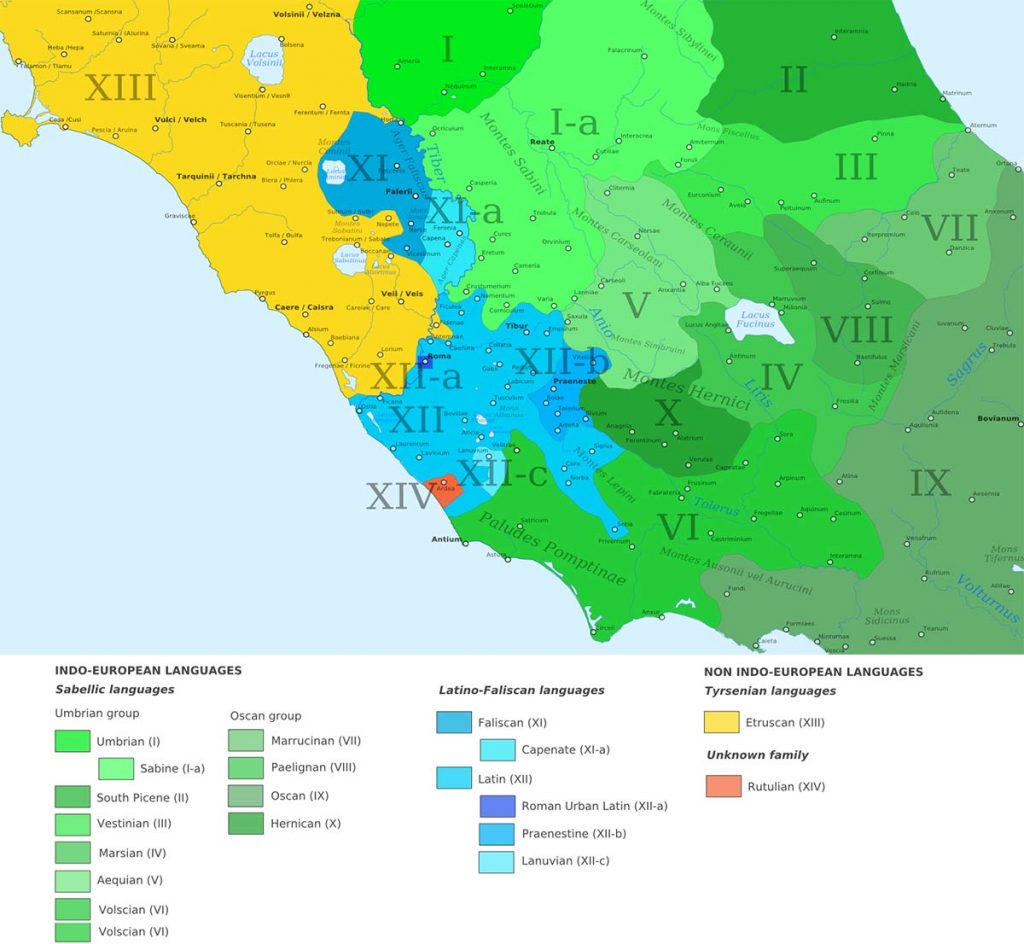
It makes sense then to test for a group of Etruscans (adding the Villanovan sample) and another of Italic peoples, to distinguish between a hypothetic ancestral Italic ancestry from a Tyrrhenian one:
NOTE. Fine-tuning groups based on the position of samples in the PCA or the amount of this or that component, or – even worse – based on the good or bad fits relative to the tested populations risks breaking the rules of subgroup analysis, eventually obtaining completely useless results, so interpretations for the Italic cluster need to be taken with a pinch of salt (until more similar Italic samples are published). The lack of proper rules regarding what can and cannot be done with this combined archaeological – genomic research is already visible to some extent in genetic papers which use brute force qpAdm tests for all available sampled populations, instead of selecting those potentially ancestral to the studied groups.
Tabs are organized from ‘better’ to ‘worse’ fits. In this case, as a general guide to the spreadsheets, the first tabs (to the left) show better fits for Italic peoples, and as tabs progress to the right they show ‘better’ fits for Etruscans, until it reaches the ‘infeasible’ or otherwise bad models.
This is what can be inferred from the models:
1) Steppe ancestry: Italic peoples seem to show better fits for north-western Alpine sources, closest to Bell Beakers from France or South Germany; whereas Etruscans show a likely Transdanubian source, closest to late Bell Beakers from Hungary (excluding Steppe- and WHG-related outliers).
To see if Bell Beakers from the south-west could be related, I tried the same model as in Fernandes et al. (2019), selecting Iberian BBC samples with more Steppe ancestry – to simplify my task, I selected them according to their PCA position. In a second attempt, I tried adding those intermediate with Iberia_CA, and it shows decreasing p-values, suggesting that the most likely source is close to high Steppe-related Bell Beaker populations. In both cases, models seem worse than France or Germany Bell Beakers.
Since Celtic spread with France BBC-like Urnfield peoples, and Italic peoples appear to be also ancestrally connected to this ancestry, the most plausible explanation is that they share an origin close to the Danubian EBA culture, which would probably be easily detectable by selecting precise Bell Beaker groups from South Germany.
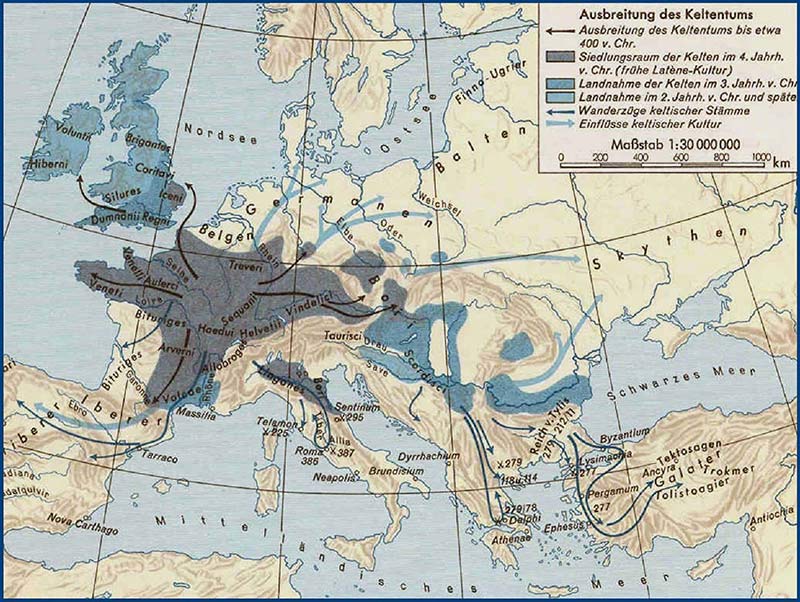
2) Anatolia_Neolithic ancestry: different tests seem to show that fits for EEF-related ancestry get warmer the closer the source population selected is to North-West Anatolian farmers, in line with the apparent shift from the East Bell Beaker cluster toward the Anatolia Neolithic cluster in the PCA:
These analyses suggest that there was a renewed Anatolia_N-like contribution during the Bronze Age, older than these Iron Age populations, but later than the rebound of WHG ancestry found among Late Neolithic and Chalcolithic samples from Italy, Sicily, or Sardinia, reflected in their shift in the PCA towards the WHG cluster.
From a range of chronologically closer groups clustering near Anatolia_N, the source seems to be closest to Neolithic samples from the Peloponnese. The direct comparison of Greece_Peloponnese_N against Italy_CA in the analyses labelled “Strict” shows that the sampled Greece Late Neolithic individuals are closer to the source of Neolithic ancestry of Iron Age Etrurians than the Chalcolithic samples from Remedello, Etruria, or Sardinia.
NOTE. Most qpAdm analyses are done with a model similar to Ning et al. (2019), using Corded_Ware_Germany.SG as an outgroup instead of Italy_Villabruna, because I expected to test all models against Yamnaya, too, but in the end – due to the many potential models and my limited time – I only tested those with ‘better’ fits:
Using Yamnaya_Kalmykia as outgroup gives invariably ‘worse’ results, as expected from Bell Beaker-derived populations who are directly derived from Yamnaya, despite their potential admixture with local Corded Ware peoples through exogamy during their expansion in Central Europe. The differences between Italic and Etruscan peoples have to be looked for mainly in EEF-related contributions, not in Steppe-related populations.
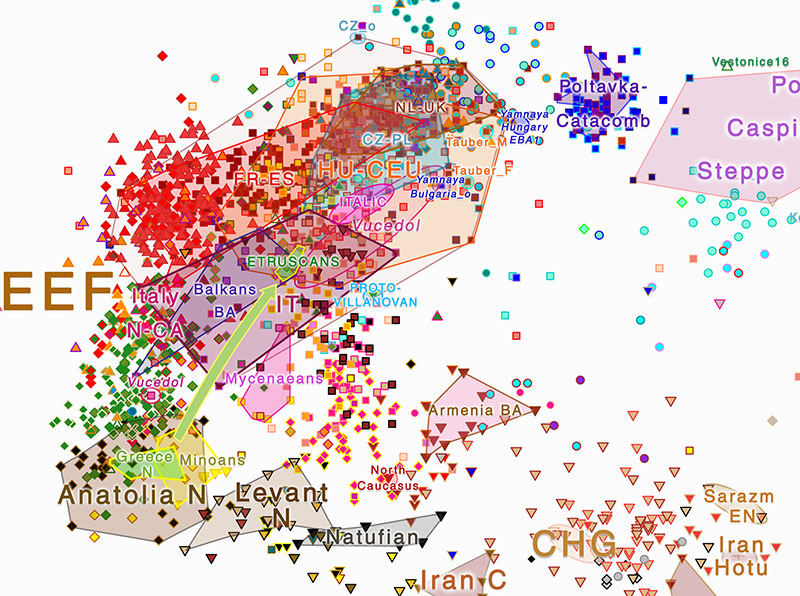
Etruscans and Sea Peoples
The sister clade of the Etruscan branch, J2b-PH1602 (TMRCA ca. 1100 BC), seems to have spread in different directions based on its modern distribution, and their global parent clade J2b-Y15058 (TMRCA ca. 1900 BC) was previously found in Veliki Vanik. J2b-L283 appears related to Neolithic expansions through the Mediterranean, based on its higher diversity in Sardinia, although its precise origin is unclear.
Based on the modern haplogroup distribution and on the TMRCA, it can be assumed that a community spread with hg. J2b-Z38240 from somewhere close to the Balkans coinciding with the population movements of the Final Bronze Age. Whether this haplogroup’s Middle Bronze Age area, probably close to the Adriatic, was initially Indo-European-speaking or was related to a regional survival of Etruscan-speaking communities remains unclear.
Greece Late Neolithic is probably the closest available population (from those sampled to date) geographically and chronologically to the Bronze Age North-Western Anatolian region, where the Tyrsenian language family is hypothesized to have expanded from.
We only have a few Iron Age samples from Etruria, dating from a period of complex interaction in the Mediterranean – evidenced by the relatively high proportion of outliers – so it is impossible to discard the existence of some remnant Bronze Age population closer to the Adriatic – from either the Italian (Apulia?) or the Balkan coasts – expanding with the Proto-Villanovan culture and responsible for the Greece_LN-like ancestry seen among the sampled Final Bronze / Iron Age populations from central Italy.
On the other hand, taking into account the ancestry of available Italian, Sardinian and Sicilian Neolithic, Chalcolithic and Bronze Age samples, the current genetic picture suggests an expansion of a different North-West Anatolia Neolithic-related population after the arrival of Bell Beakers from the north, hence probably through the Adriatic rather than through the Tyrrhenian coast, whether the common language group formed with Lemnian had a more distant origin in Bronze Age North-West Anatolian groups or in some isolated coastal community of the Adriatic.
NOTE. Admittedly, the ancestry of the Proto-Villanovan sample seems different from that of Etruscans, although a contribution of the most likely sources for Etruscans cannot be rejected for the Proto-Villanovan individual (see ‘reciprocal’ models of admixture here). In any case, I doubt that the main ancestry of the Proto-Villanovan from Abruzzo is directly related to the population that gave rise to Etruscans, and is more likely related to recent, intense bilateral exchanges in the Adriatic between (most likely) Indo-European-speaking populations.

Northern Adriatic
This Adriatic connection could in turn be linked to wider population movements of the Final Bronze Age. Proto-Villanova represents the introduction of oriental influences coinciding with the demise of the local Terramare culture (see e.g. Cremaschi et al. 2016), whereas the Villanovan culture shows partial continuity with many Proto-Villanovan settlements where Etruscan-speaking communities later emerge. From Nicolis (2013):
Founded in the LBA, the village of Frattesina extended over around 20 hectares along the ‘Po di Adria’, a palaeochannel of the Po. It experienced its greatest development between the twelfth and eleventh centuries BC, when it had a dominant economic role thanks to an extraordinary range of artisan production (metalworking, working of bone and deer horn, glass) and major commercial influence due to trading with the Italian Peninsula and the eastern Mediterranean.
This is demonstrated by the presence of exotic objects and raw materials, such as Mycenaean pottery, amber, ivory, ostrich eggs, and glass paste. For the Mycenaean sherds found in settlements in the Verona valleys and the Po delta, analysis of pottery fabrics has shown that some of them very probably come from centres in Apulia where there were Aegean craftsmen and workers, whereas others would seem to have originated on the Greek mainland (Vagnetti 1996; Vagnetti 1998; Jones et al. 2002).
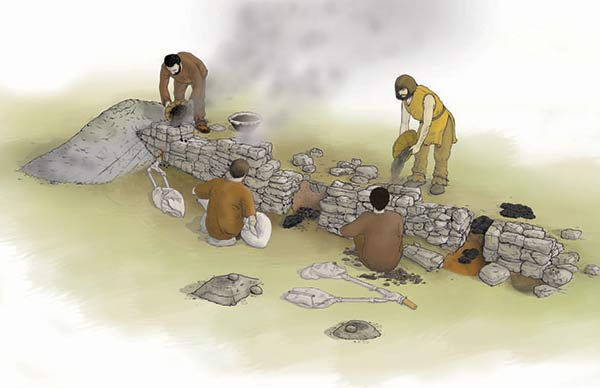
In this context a particular system of relations seems to link one specific Alpine region with the social and economic structure of the groups settling between the Adige and the Po and the eastern Mediterranean trading system. In eastern Trentino, at Acquafredda, metallurgical production on a proto-industrial scale has been demonstrated between the end of the LBA and the FBA (twelfth–eleventh centuries BC) (Cierny 2008) (Fig. 38.3). These products must have supplied markets stretching beyond the local area, linked to the Luco/Laugen culture typical of the central Alpine environment. According to Pearce and De Guio (1999), such extensive production must have been destined for the supply of metal to other markets, first of all to other centres on the Po plain, where transactions for materials of Mediterranean origin also took place.
The picture of the Final Bronze Age of these regions, which seems to be coherent with the development of the cultural setting of the Early Iron Age, shows that the birth of the proto-urban Villanovan centres of Bologna in Emilia and Verucchio in Romagna, at the beginning of the Iron Age, seems to follow a line of continuity starting with the role played by Frattesina in the Final Bronze Age (Bietti Sestieri 2008).
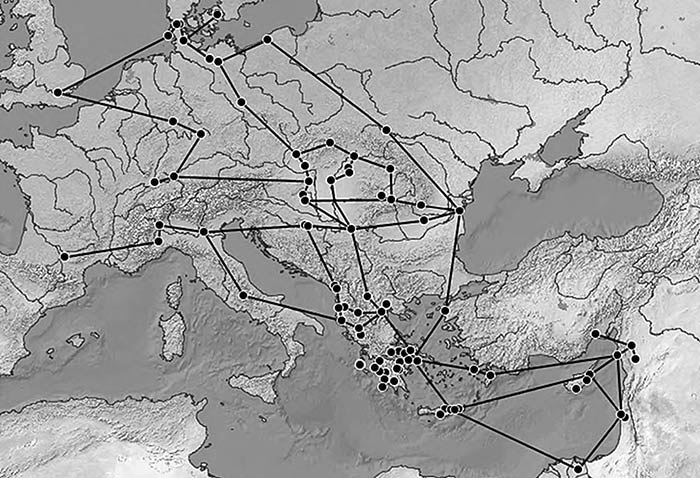
Tyrsenian
The close similarities shared by Rhaetian with the oldest Etruscan inscriptions – but not with the language of later periods, when Etruscan expanded further north – together with increased ‘foreign’ contacts in the Final Bronze Age and the ‘foreign’ ancestry of Etruscans (relative to Italian Chalcolithic and to near-by Bell Beakers) support a language split close to the Adriatic, and not long before they started using the Euboean-related Old Italic alphabet. All this is compatible with an expansion associated with the Proto-Villanovan period, possibly starting along the Po and the Adige.
From Nicolis (2013):
In this geographical context the most important morphological features are the Alps and the alluvial plain of the River Po. Since Roman times the former have always been considered a geographical limit and thus a cultural barrier. In actual fact the Alps have never really represented a barrier, but instead have played an active role in mediating between the central European and Mediterranean cultures. Some of the valleys have been used since the Mesolithic as communication routes, to establish contacts and for the exchange of materials and people over considerable distances. The discovery of Ötzi the Iceman high in the Alps in 1991 demonstrated incontrovertibly that this environment was accessible to individuals and groups from the end of the fourth millennium BC.
From the Early Neolithic period the plain of the Po Valley provided favourable conditions for the population of the area by human groups from central and eastern Europe, who found the wide flat spaces and fertile soils an ideal environment for developing agricultural techniques and animal husbandry. Lake Garda represents a very important morphological feature, benefiting among other things from a Mediterranean-type microclimate, the influence of which can already be seen in the Middle Neolithic. Situated between the plain and the mountains, the hills have always offered an alternative terrain for demographic development, equally important for the exploitation of economic and environmental resources.
As documented for previous periods, in the late and final phases of the Bronze Age the northern Adriatic coast would also seem to represent an important geographical feature, above all in terms of possible long-distance trading contacts with the Aegean and eastern Mediterranean coasts. However, the geographical and morphological characteristics and the river network in this area were very different to the way they are today, and the preferred communications routes must always have been the rivers, particularly the Po and the Adige.
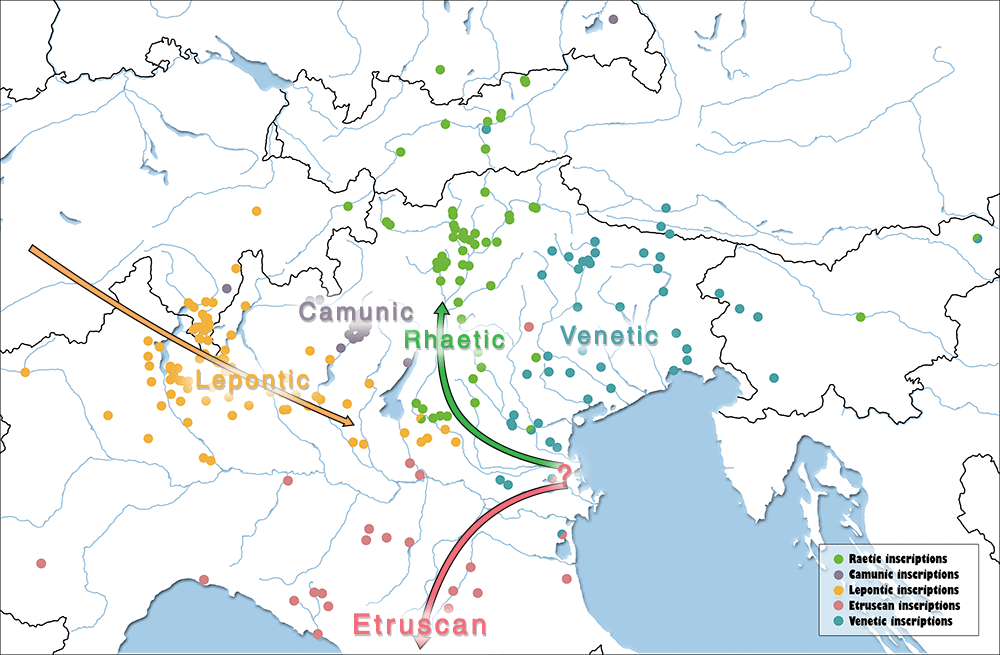
Conclusion
Although it seems superfluous at this point, finding mostly Yamnaya-derived R1b-L23 lineages among speakers of another early North-West Indo-European dialect – and also the earliest to have split into its attested dialects – gives still more support to Yamnaya steppe herders as the vector of expansion of Late PIE, and their continuity up to the Iron Age also supports the strong patrilineal ties of Indo-Europeans.
This, in turn, further supports the nature of Afanasievo as the earliest separated branch from a Late Proto-Indo-European trunk, and of Khvalynsk as the Indo-Anatolian community, while a confirmation of R1b-L23 among early Greeks (speaking the earliest attested Graeco-Aryan dialect) will indirectly confirm East Yamnaya/Poltavka as the early Proto-Indo-Iranian community.
As it often happens with genetic sampling, due to many uncontrollable factors, there is a conspicuous lack of a proper regional and chronological transect of Bell Beaker and Bronze Age samples from Italy, which makes it impossible to determine the origin of each group’s ancestral components. Even though the sampled Italian Beakers don’t seem to be the best fit for Iron Age Italic-speaking peoples from Etruria, they still might have formed part of the migration waves that eventually developed the Apennine culture together with those of prevalent West-Central European Bell Beaker ancestry.
Similarly, the visible radical change from the increasingly WHG-shifted Italian farmers up to the sampled Chalcolithic individuals, including Parma Bell Beakers, to the Anatolia_N-shifted ancestry found in Iron Age Etruscans and Latins might be related to earlier population movements associated with Middle or Late Bronze Age contacts, and not necessarily to the radical social changes seen in the Final Bronze Age. The Etruscan subclade with a likely origin in the Balkans, on the other hand, suggests recent migrations from the Adriatic into Etruria.

Until there is more data about these ancestry changes in Italy, the Balkans, and North-West Anatolia, I prefer to leave the Tyrsenian origins up in the air, so I deleted the Lemnian -> Etruscan arrow of the map of Late Bronze Age migrations, if only because an arrival through the Tyrrhenian Sea has become much less likely. An East -> West movement is still the most likely explanation for the common Tyrsenian language, culture, and ancestry, but the only Y-DNA haplogroup available seems to have an origin closer to the Adriatic.
The recent study of Sea Peoples showed – based on the previous hypothesis of the language and culture of the Philistines – that a minority of incoming elites must have imposed the language as their genetic ancestry (including haplogroups) became diluted among a majority of local peoples. Similarly, the original genetic pool of Tyrsenian speakers might have become diluted among different groups due to their more complex social organization, similar to what happened to Italic peoples during the Imperial period.
One of the most interesting aspects proven in the paper – and strongly suspected before it – is the reflection in population genomics of the change in the social system of the Italian Peninsula during the Roman expansion, and even before it during the Etruscan polity. In fact, it was not only Romans who spread and genetically influenced other European regions, but other regions – especially the more numerous Eastern Mediterranean populations – who became incorporated into a growing Etrurian community which nevertheless managed to spread its language.
In other words, Tyrsenian spread through central and northern Italy, and Latin throughout the whole Mediterranean area and mainland Europe, not (only) through population movements, but through acculturation, in a growing international system of more complex political organizations that can be inferred for most population and language expansions since the Early Iron Age. East Mediterranean populations, Scythians and other steppe peoples, East Germanic peoples, Vikings, or North-Eastern Europeans are other clear examples known to date.
Related
- European hydrotoponymy (V): Etruscans and Rhaetians after Italic peoples
- Sea Peoples behind Philistines were Aegeans, including R1b-M269 lineages
- European hydrotoponymy (I): Old European substrate and its relative chronology
- European hydrotoponymy (II): European hydrotoponymy (II): Basques and Iberians after Lusitanians and “Ligurians”
- European hydrotoponymy (III): from Old European to Palaeo-Germanic and the Nordwestblock
- European hydrotoponymy (IV): tug of war between Balto-Slavic and West Uralic
- Y-DNA relevant in the postgenomic era, mtDNA study of Iron Age Italic population, and reconstructing the genetic history of Italians
- Pre-Roman and Roman mitogenomes from Southern Italy
- Ancient Sardinia hints at Mesolithic spread of R1b-V88, and Western EEF-related expansion of Vasconic
- Arrival of steppe ancestry with R1b-P312 in the Mediterranean: Balearic Islands, Sicily, and Iron Age Sardinia
- Y-DNA relevant in the postgenomic era, mtDNA study of Iron Age Italic population, and reconstructing the genetic history of Italians
- Modern Sardinians show elevated Neolithic farmer ancestry shared with Basques
- Ancient Phoenician mtDNA from Sardinia, Lebanon reflects settlement, genetic diversity, and female mobility
- Haplogroup J spread in the Mediterranean due to Phoenician and Greek colonizations
